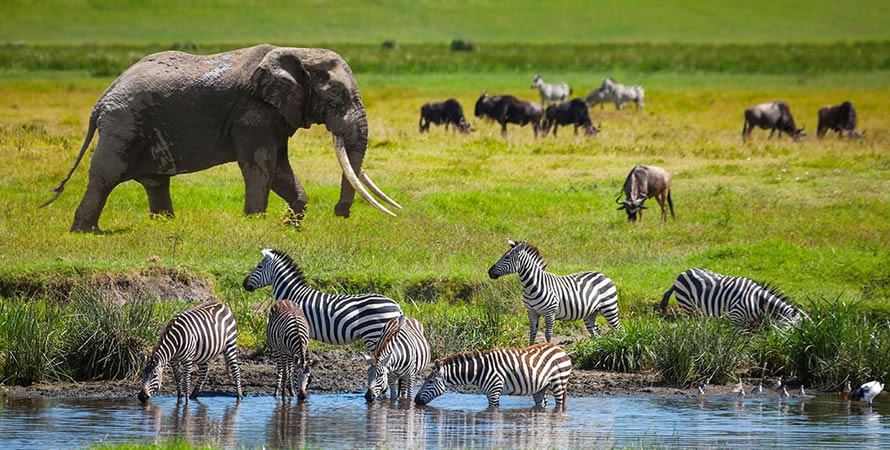Self Drive Guide Serengeti National Park
Serengeti National Park is the oldest national park in Tanzania, a UNESCO World Heritage site, a biosphere reserve, and one of the seven wonders of Africa. Serengeti National Park is a renowned wildlife sanctuary, celebrated for its natural beauty and stunning landscapes. Situated in the northern circuit of Tanzanian tourism, it has the highest concentration of plains game in both Tanzania and Africa.

Serengeti National Park was formed in 1952, making it the first national park created in Tanzania. Serengeti National Park hosts a high concentration of wildlife, including lions, elephants, cheetahs, giraffes, and other bird species, and is renowned for the extraordinary spectacle of the annual migration of wildebeest and zebras.
Serengeti National Park is the second-largest park in Tanzania, encompassing an area of 14,763 square kilometers, equivalent to 5,700 square miles. This area is the largest among the more than 18 national parks in Tanzania, surpassed only by Ruaha National Park, which covers approximately 20,226 square kilometers.
The wildebeest migration is arguably the most renowned event in Serengeti National Park, as over one million wildebeest and approximately 200,000 zebras migrate from the northern hills to the south during the short rains in October and November, subsequently moving west to the north following the long rains from April to June. Throughout their migration, wildebeest traverse numerous national parks, protected areas, and reserve areas.
Divisions of Serengeti National Park
The park is partitioned into four areas, one of which is the Seronera Valley, a renowned area in the southern-central part of the park, referred to by the Maasai as “serengit,” meaning the endless plain. This section is distinguished by its classic savannah, acacia trees, and a rich diversity of species.
The second segment, known as the Western Corridor, is characterized by the Grumeti River, which the great migration traverses from late May to early June. In this corridor, tourists may observe wildebeest navigating past leopards, lions, and Nile crocodiles. This region is also distinguished by a greater presence of forest and extensive underbrush.
The third segment, located in the northern half of the park, is referred to as the Lobo area, which borders the Maasai Mara Reserve in Kenya. By early July, the migration progresses to a location where the majority of the animals will reside until September. This region contains more trees and hills and is the least frequented area.
The final section is the southern Serengeti, characterized by short grass plains, where the big migration commences. From December to March, the population of wildebeest increases, forming a herd in the southern region of the park near Lake Ndutu, which is shared by both the Serengeti and the Ngorongoro Conservation Area.
Attractions in Serengeti National Park
The Big Five—lion, leopard, elephant, buffalo, and rhinoceros—are all present in Serengeti National Park. They entice individuals to engage in game drives and viewing, as many aspire to observe the creatures renowned as the “big five,” which possess a significant historical legacy.
Wildlife increase: In addition to the Big Five, numerous other mammals, both large and small, contribute to a park’s ability to get good comments regarding tourist pleasure. Their composition encompasses hippos, giraffes, impalas, gazelles, warthogs, felines, and numerous additional species.
Local inhabitants surrounding the park significantly contribute to attracting tourists by facilitating the organization of cultural trips. Various scholars conduct research on the Maasai tribe, particularly focusing on their culture.
The Great Migration may be the primary cause for the global renown of Serengeti National Park, as it is frequently inquired about by tourists. This remarkable natural phenomenon draws numerous individuals engaged in both domestic and international tourism.
Varieties of birds: A multitude of avian species draws several travelers to Serengeti National Park for birdwatching tourism. The Serengeti is home to turkeys, ostriches, rollers, and numerous other bird species, enhancing the experience for tourists.
Best Time to Visit Serengeti National Park
The best time to visit Serengeti National Park is year-round, as each season offers significant events for tourists to observe and enjoy. In the dry season (May to October), there is a considerable concentration of animals around water sources, facilitating game viewing; nonetheless, the optimal period to observe the big migration of wildebeest is from November to May.
Accessing Serengeti National Park
Serengeti National Park is reachable via both road and air transportation. Tourists utilize 4×4 safari jeeps for road transport, the predominant mode of transit to Serengeti National Park, departing from Kilimanjaro International Airport or Arusha Regional Airport. The journey from Arusha to Naabi Hill at the entrance gate will require approximately 5 to 6 hours, as it spans a distance of nearly 255 kilometers. The journey from Naabi Hill to the Serengeti National Park headquarters takes around one hour. Although the use of private vehicles is permitted, self-drive safaris are not advisable.
There are regional and international flights available by air. Regional airlines comprise Air Excel, Coastal Aviation, and Aviation Air. International airlines include KLM, Turkish Airlines, Ethiopian Airlines, British Airways, Emirates, and others that operate flights to Dar es Salaam, with connections available at Kilimanjaro International Airport. Kilimanjaro International Airport serves as the optimal point of entry, situated between the tourist cities of Arusha and Moshi, from which travelers can access charter flights to the Serengeti. Private fly safaris are scheduled from Arusha Regional Airport to Serengeti National Park, which contains approximately seven airstrips.
Accommodations within Serengeti National Park
Guests need not worry about accommodation, as numerous options are available both within and outside the park. Within the park, there are several accommodation options, including luxury and standard tented lodges, campsites, rest houses, and hostels. Additionally, in proximity to the park, there exist various accommodations, including hotels of diverse pricing, camping sites, and lodges such as Serengeti Simba Lodge, Serengeti Soap Lodge, Serengeti Serena Lodge, Lahia Tented Lodge, Kati Kati Tented Camp, Kubu Kubu Tented Camp, Serengeti Explorer Camp, Serengeti Acacia Camp, Acacia Seronea Luxury Camp, Nimali Serengeti, and Nimali Mara Camps.
